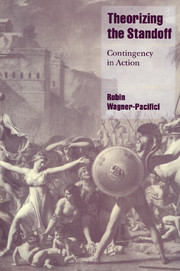3 - The spaces of the standoff
Published online by Cambridge University Press: 22 September 2009
Summary
The bridge indicates how humankind unifies the separatedness of merely natural being, and the door how it separates the uniform continuous unity of natural being.
(Georg Simmel, “Bridge and Door,” p. 9)Senator Specter to Randy Weaver: So would you please walk over to the mock-up and point out where your home is located and where that door was located?
Mr. Weaver to Senator Specter: … That all looks pretty good. This is where my son was laying, in this shed here. This is what we called the front door. That door opened like this on that front porch – closed – open –
(Senate Hearings on Ruby Ridge, p. 63)Just as there is a need to situate the standoff in time, so there is a need to locate it in space. The practical and symbolic imperatives of space provide a multidimensional map for the participants. As well, as anyone who has ever found themselves in a competition for a parking space knows, conflicts over space itself can lead to standoffs. Again in this as in previous chapters, I will carry forward the project to develop an analysis of the contingent elements of standoffs. Here, the goal is to analyze both the binarism of the wealth of dyadic oppositional terms linked to the spaces of standoffs as well as the interactional qualities of the mediating terms and concepts that travel back and forth between them.
- Type
- Chapter
- Information
- Theorizing the StandoffContingency in Action, pp. 96 - 136Publisher: Cambridge University PressPrint publication year: 2000

